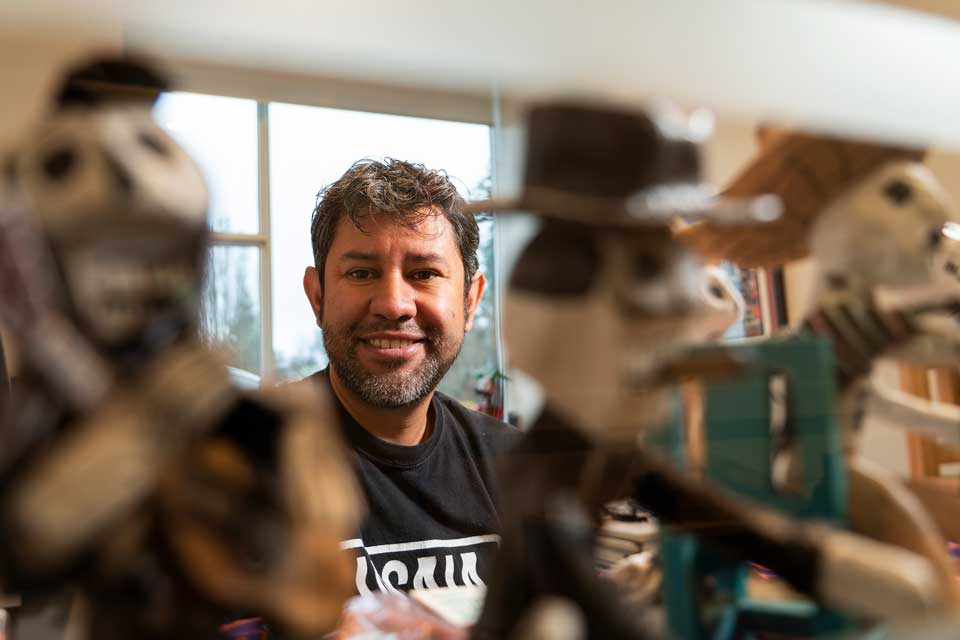Drug-checking programs can track the flow of fentanyl North America—and shine a light on new substances that could make the drug-poisoning crisis more deadly.
Mexico and Canada may be physically separated by thousands of kilometres, but people like Jaime Arredondo Sanchez Lira are working to bring them closer together when it comes to harm reduction and drug policy.
Arredondo is the new Canada Research Chair in Substance Use and Health Policy Research, a professor in UVic’s School of Public Health and Social Policy, and a scientist with the Canadian Institute for Substance Use Research (CISUR). He comes to UVic from the Centre for Research and Teaching in Economics (CIDE) in Aguascalientes, Mexico, where he was a professor in the Drug Policy Program.
“I had a not-so-traditional transition to academia,” Arredondo explains. “Before grad school, I worked in the Mexican government in the Ministry of Public Safety in the state of Quintana Roo, where the popular Cancun resort community is located.” This means his first experience in public policy was closely related to public safety, particularly policing. After leaving government to start his graduate studies in San Diego, he began to look at violence and the US-led war on drugs as public-health issues, not criminal ones, and worked to understand how police themselves could be risk factors for HIV—both for people who use drugs, and for officers themselves, as aggressive tactics used by police against people who used drugs put them all at risk.
Canadian connections
Arredondo’s work in Tijuana implementing a fentanyl drug-checking program with the harm reduction organization Prevencasa led him to the BC Centre on Substance Use in Vancouver. Getting to know the DTES community helped him explore new research ideas around implementing innovative projects in his home country of Mexico and his temporary home in Canada.
“I got to know many of the interventions that are now standard in British Columbia, like naloxone distribution and overdose prevention sites and adapt them to the reality of Mexico and the US/Mexico border,” he says.
Arredondo returned to Mexico, specifically Mexicali and the border town of Tijuana, to help put policies such as overdose prevention sites and drug checking into place. He has worked with charities such as Integración Social Verter, which set up La Sala, the only supervised consumption site in Latin America, and the fourth in the world specifically for women. He also started a safe smoking distribution program in Baja California. But given the very different status of harm reduction and drug markets in Mexico versus Canada, there are hurdles to overcome, particularly around the power of organized crime in Mexico and how it relates to harm reduction.
“Trying to create a drug-checking service might be a little scarier in Mexico where a lot of community organizations, leaders, journalists or people who used substances are getting killed by disputes with organized crime,” Arredondo says. “To our surprise, we haven’t had any problems with violence from organized crime when it comes to harm reduction. It was more the government who showed resistance to the ideas.” The Mexican government cut all funding for harm reduction in the country in 2018, making it hard to sustain services without external help or research grants.
Harm reduction without borders
With his new CRC appointment, Arredondo is shifting much of his base to Victoria, but his work in Mexico and beyond continues. He says these countries, as well as the US, have a lot to learn from each other in terms of how we approach harm reduction and treat people who use drugs. His work assessing decriminalization in Mexico helped him understand that the law on the books is not always followed by implementation on the ground.
These countries are linked by free trade agreements like NAFTA, but also by informal markets such as the political economy of drugs. I think they all have common issues. One of them is the vulnerabilities around people who use substances and the stigma surrounding substance use. That seems to be equally harmful throughout our region.”
—Jaime Arredondo, Canada Research Chair in Substance Use and Health Policy Research at UVic
Mapping the North American drug supply
A new project Arredondo is involved in will help connect his Mexican and Canadian research with what is happening on the US west coast. This region is also seeing a need for harm reduction services, like drug checking and supervised consumption sites, in the face of rising fentanyl-related overdoses due to a contaminated drug supply, largely coming from Mexico. A new partnership between the OnPoint San Diego needle exchanges service, local health departments and the University of California San Diego, will try to implement community-based drug checking similar to UVic’s Vancouver Island Drug Checking Project.
“This new community service in San Diego has the potential to be one key element in the development of a pacific-wide drug monitoring system,” explains Arredondo. “The introduction of fentanyl in the Canadian and BC drug supply is a phenomenon being replicated in other western North American cities, like San Diego and Tijuana. We need to take actions to save lives now.”
The concept of interconnected drug-checking projects set up across North America could tell us a lot about the rapidly changing drug supply as it travels around the continent. Identifying some unexpected results of where adulterants, such as benzodiazepines, are appearing up in the supply chain can help share harm-reduction knowledge among community organizations and governments.
“Drug-trafficking organizations in Mexico seem to be adapting to new demands for stronger opioids in Canada and the US. Now, more than ever, substance use issues must be seen as a common challenge in the North American region,” explains Arredondo. “Just as fentanyl was first introduced in Canada, other new substances in the local drug supply could represent future challenges for the health of the North American region. This is why fostering programs across countries, with lessons about their success and failures, becomes an important topic to put on the table.”

